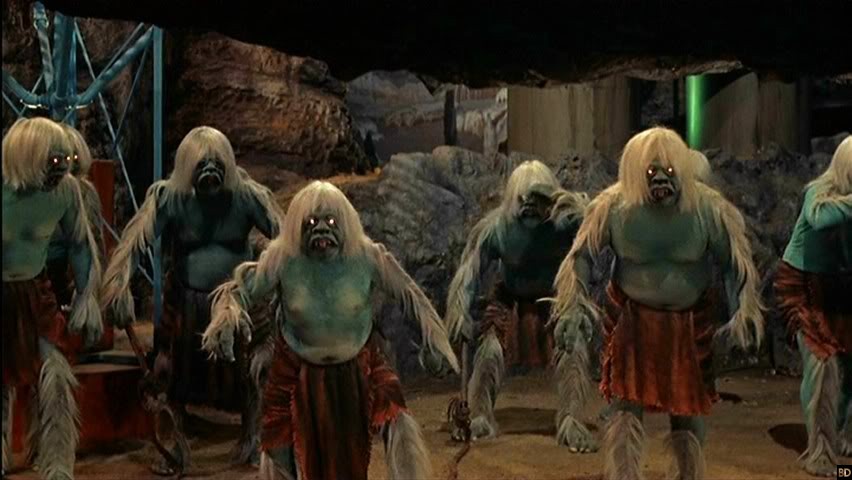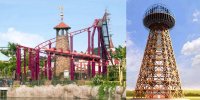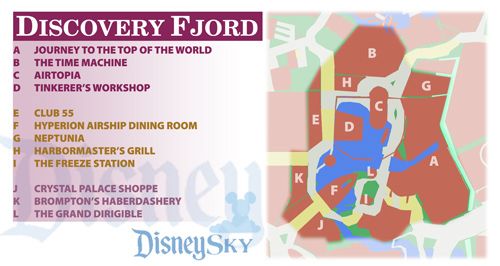Continuing with the queue for our E-ticket Flight to the Top of the World.

Nemo’s Office
The queue peers through relocated Nautilus portholes onto Captain Nemo’s final private quarters and office. Open notebooks and handmade maps clue in attentive guests to the ride’s story. Nemo has charted a course for the North Pole, with a route passing underneath Mt. Helios. Scientific sketches depict Mt. Helios’ slopes, and foreshadow its verdant Lost Worlds. Compartments overflow with arctic exploration equipment, with nautical charts and discarded ice drills. An early cloud atlas book sits prominently on Nemo’s desk.
A sharply angled ridgeline walkway separates the office overlook from one final icy chamber. Again we are entirely within the glacier, and very near its top, as only a thin ceiling of ice separates guests from the moonlit night sky above - with this lighting effect we establish the ride’s perpetual nighttime Arctic setting. Guests walk along metal catwalks - more scavenged Nautilus machinery - which leads downwards. Below is the oxidized bronze rooftop of the hidden Zephyr hangar, complete with a windsock frozen solid. The catwalk stairways pass down through a skylight panel and into the hangar interior from above.

The Zephyr Hangar
Guests descend into the hangar’s upstairs office, which much like the Indiana Jones Adventure queue crosses over the ride’s final stretch. This is where the FastPass and standby lines merge.
A bank of convex windows looks out onto the hangar’s main chamber beyond...or actually onto a forced perspective illusion of the chamber. Above is the ribbed steel ceiling, and below is the top of a Zephyr airship balloon.


The carefully-staged office, located past queue fencing, serves as Blauerhimmel’s design space. There are blueprints and vintage photos of the Zephyr flying machine, and even a scale model of the airship inside a case. Sketches & illustrations & maps all over the walls and desks visually spell out more ride backstory, with more foreshadowing: Architectural plans of Discovery Glacier, topographical maps of Mt. Helios, watercolors of a snow-capped shipwreck graveyard, sketches of a shadowing Winter Giant. A furnace serves as the lone heat source, with the room increasingly frosty the further away it is. A framed note sits prominently on the wall for guests who are passionate enough to read it. “Captain Nemo - Final Message,” it begins, before laying out Nemo’s quest to locate an “Eden to the North” to serve as Man’s refuge from war.
Stairs on the hangar’s far side lead down from the office, beneath dangling chains pocked in icicles. Down we go to a pre-loading platform within the main hangar bay. Unseen workers can be heard hammering away, readying us for flight. Tools and canisters of hydrogen neatly line the edges. Victorian windows peering outside reveal that the hangar is half-buried in a snowbank. Beyond is a vast expanse of Arctic wasteland. A howling snowstorm bathes in eternal northern twilight.

Loading Sheds
Oxidized golden switchbacks wind towards two corrugated metal sheds. These sheds block complete views of a Zephyr airship, with only its stately balloon towering over the sheds.
These sheds actually serve as a pair of loading rooms, small in scale and sealed by doors on both sides. There is just enough room inside for 12 guests and one dedicated cast member, part of Blauerhimmel’s flight crew. Sounds heard outside the shed imply that workmen are finalizing work on the airship. Black-and-white photographs of the craft in mid-flight line the bare metal walls.

Loading shed interior, and an impression of the Zephyr cabin
Guests never directly see ride vehicles arriving on their tracks; rather, once the inner doors open, guests directly board the Zephyr’s suspended cabin. Actually two airship cabins board at once, from two side-by-side shed chambers...somewhat like the Indiana Jones Adventure loading setup, minus the split-track. However, care is taken to fully immerse each group of 12 guests into their own one-of-a-kind dirigible voyage.

Ride Vehicles - Zephyr Airship Cabins
The ride vehicles are suspended EMVs (Enhanced Motion Vehicles). Visually they resemble an airship’s gondola cabin, complete with ceiling. Tiered seating provides three rows with four seats across, with individual lap bars. The gondola is tall enough to stand in. Like a Star Tours starship, there are great views from every seat. Open air window frames line the sides and front. The front window in particular resembles the Nautilus’ circular “eye”. For now the eye is sealed shut by a metal frame bearing Nemo’s seal, which blocks views of other airship gondolas ahead.

Mechanically, these suspended EMVs combine a few preexisting ride systems. A motion base within the vehicles allows for flight simulator-style motions, to complement the physical set pieces. Suspended from an overhead track, a scissor lift above the ceiling is able to both A) simulate hair-raising drops, and B) lower gently to the ground level in case of evac. The trams on Universal’s original Kongfrontation are an old school example of a similar ride vehicle, and can be used as a substitution in case our proposed “Suspended EMV” system doesn’t work.
Tomorrow, the ride begins!
Nemo’s Office
The queue peers through relocated Nautilus portholes onto Captain Nemo’s final private quarters and office. Open notebooks and handmade maps clue in attentive guests to the ride’s story. Nemo has charted a course for the North Pole, with a route passing underneath Mt. Helios. Scientific sketches depict Mt. Helios’ slopes, and foreshadow its verdant Lost Worlds. Compartments overflow with arctic exploration equipment, with nautical charts and discarded ice drills. An early cloud atlas book sits prominently on Nemo’s desk.
A sharply angled ridgeline walkway separates the office overlook from one final icy chamber. Again we are entirely within the glacier, and very near its top, as only a thin ceiling of ice separates guests from the moonlit night sky above - with this lighting effect we establish the ride’s perpetual nighttime Arctic setting. Guests walk along metal catwalks - more scavenged Nautilus machinery - which leads downwards. Below is the oxidized bronze rooftop of the hidden Zephyr hangar, complete with a windsock frozen solid. The catwalk stairways pass down through a skylight panel and into the hangar interior from above.
The Zephyr Hangar
Guests descend into the hangar’s upstairs office, which much like the Indiana Jones Adventure queue crosses over the ride’s final stretch. This is where the FastPass and standby lines merge.
A bank of convex windows looks out onto the hangar’s main chamber beyond...or actually onto a forced perspective illusion of the chamber. Above is the ribbed steel ceiling, and below is the top of a Zephyr airship balloon.

The carefully-staged office, located past queue fencing, serves as Blauerhimmel’s design space. There are blueprints and vintage photos of the Zephyr flying machine, and even a scale model of the airship inside a case. Sketches & illustrations & maps all over the walls and desks visually spell out more ride backstory, with more foreshadowing: Architectural plans of Discovery Glacier, topographical maps of Mt. Helios, watercolors of a snow-capped shipwreck graveyard, sketches of a shadowing Winter Giant. A furnace serves as the lone heat source, with the room increasingly frosty the further away it is. A framed note sits prominently on the wall for guests who are passionate enough to read it. “Captain Nemo - Final Message,” it begins, before laying out Nemo’s quest to locate an “Eden to the North” to serve as Man’s refuge from war.
Stairs on the hangar’s far side lead down from the office, beneath dangling chains pocked in icicles. Down we go to a pre-loading platform within the main hangar bay. Unseen workers can be heard hammering away, readying us for flight. Tools and canisters of hydrogen neatly line the edges. Victorian windows peering outside reveal that the hangar is half-buried in a snowbank. Beyond is a vast expanse of Arctic wasteland. A howling snowstorm bathes in eternal northern twilight.
Loading Sheds
Oxidized golden switchbacks wind towards two corrugated metal sheds. These sheds block complete views of a Zephyr airship, with only its stately balloon towering over the sheds.
These sheds actually serve as a pair of loading rooms, small in scale and sealed by doors on both sides. There is just enough room inside for 12 guests and one dedicated cast member, part of Blauerhimmel’s flight crew. Sounds heard outside the shed imply that workmen are finalizing work on the airship. Black-and-white photographs of the craft in mid-flight line the bare metal walls.
Loading shed interior, and an impression of the Zephyr cabin
Guests never directly see ride vehicles arriving on their tracks; rather, once the inner doors open, guests directly board the Zephyr’s suspended cabin. Actually two airship cabins board at once, from two side-by-side shed chambers...somewhat like the Indiana Jones Adventure loading setup, minus the split-track. However, care is taken to fully immerse each group of 12 guests into their own one-of-a-kind dirigible voyage.
RIDE STATS
Ride type: Suspended EMV dark ride
Capacity per cabin: 12 (3 rows of 4)
Hourly capacity: 2,160
Duration: 3:38
Height restriction: 46”
Ride type: Suspended EMV dark ride
Capacity per cabin: 12 (3 rows of 4)
Hourly capacity: 2,160
Duration: 3:38
Height restriction: 46”
Ride Vehicles - Zephyr Airship Cabins
The ride vehicles are suspended EMVs (Enhanced Motion Vehicles). Visually they resemble an airship’s gondola cabin, complete with ceiling. Tiered seating provides three rows with four seats across, with individual lap bars. The gondola is tall enough to stand in. Like a Star Tours starship, there are great views from every seat. Open air window frames line the sides and front. The front window in particular resembles the Nautilus’ circular “eye”. For now the eye is sealed shut by a metal frame bearing Nemo’s seal, which blocks views of other airship gondolas ahead.
Mechanically, these suspended EMVs combine a few preexisting ride systems. A motion base within the vehicles allows for flight simulator-style motions, to complement the physical set pieces. Suspended from an overhead track, a scissor lift above the ceiling is able to both A) simulate hair-raising drops, and B) lower gently to the ground level in case of evac. The trams on Universal’s original Kongfrontation are an old school example of a similar ride vehicle, and can be used as a substitution in case our proposed “Suspended EMV” system doesn’t work.
Tomorrow, the ride begins!
Last edited:













